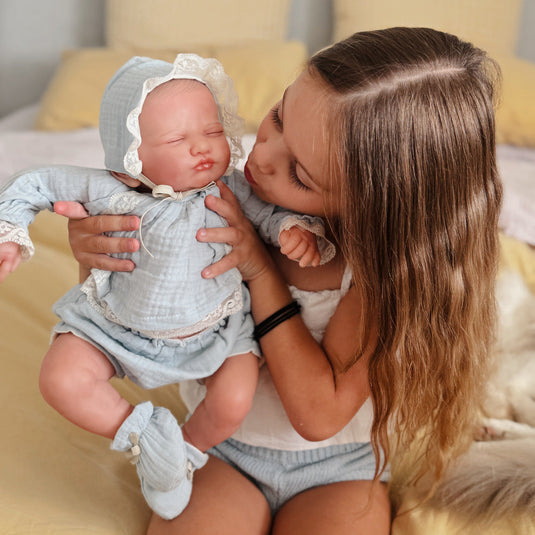More About Dolls And Accessories
Wiki Article
Little Known Questions About Dolls And Accessories.
Table of ContentsDolls And Accessories Can Be Fun For AnyoneSome Known Details About Dolls And Accessories 7 Simple Techniques For Dolls And AccessoriesThe 7-Second Trick For Dolls And AccessoriesFacts About Dolls And Accessories RevealedDolls And Accessories for BeginnersGetting The Dolls And Accessories To Work
When dolls are included in group play, kids practice waiting, sharing, and paying attention to others' ideas. Whether they're acting to be a moms and dad, brother or sister, or pal, youngsters learn exactly how connections workhow to support others, solve disagreements, and look after someone else. These very early role-play experiences come to be the foundation for healthy friendships and partnerships later on in life.Repeating comforting routines with a doll (feeding, shaking, placing to bed) can aid children feel calm and safe. These calming routines show them how to self-regulate. Looking after a doll can make a kid feel capable and confident - dolls. It provides them a sense of responsibility and control in a world that commonly really feels unpredictable.
Unknown Facts About Dolls And Accessories
When youngsters see dolls that mirror their race, heritage, and society, it reinforces a favorable feeling of identity. It states, "You belong. Your tale matters." Dolls additionally introduce kids to cultures outside their own, building considerate curiosity and compassion for others. This is where comprehensive play can lead to comprehensive areas.As Dr. Karyn Purvis, a leader in child advancement and trauma-informed care, once stated: This powerful quote highlights how play isn't simply funit's exactly how children find out finest. The brain cords itself via repetition. But when a kid is involved, cheerful, and emotionally connected to an activitylike doll playthe brain enhances those connections faster and much more meaningfully.
The Greatest Guide To Dolls And Accessories

Kids need empathy, kindness, and creativity tooand doll play offers that. Dolls are typically a child's first "buddy," helping them exercise partnerships, construct communication skills, and feel comforted.
Little Known Questions About Dolls And Accessories.
Via dolls that matter. Samantha Ong Samantha Ong is the founder of Joeydolls, a Canadian-based toy brand on a goal to celebrate Eastern cultures via happy, inclusive play. Influenced by her own experiences growing up without social depiction, Samantha makes dolls that help youngsters feel pleased of who they are while triggering curiosity and empathy in others.Having fun with dolls urges youngsters to speak even more regarding others' ideas and feelings, a research has actually located. The research recommends that playing fictional video games with dolls might help kids create social skills, theory of mind and compassion. The neuroscientist who led the job stated that the educational worth of having fun with Lego and building and construction playthings was commonly accepted, yet the advantages of playing with dolls occasionally appeared to have been forgotten."When youngsters develop imaginary globes and duty have fun with dolls, they interact in the beginning aloud and after that internalise the message regarding others' thoughts, emotions and sensations," stated Dr Sarah Gerson, a neuroscientist at Cardiff College and the lead author.
Unknown Facts About Dolls And Accessories
They were additionally more likely to resolve the dolls in the second person, speaking with them directly, whereas the characters on the computer display they often tended to describe in the 3rd person. No distinction was observed in between children and girls."Inner state language can indicate that moved here a youngster is thinking of other individuals's ideas and emotions while playing with dolls," stated Gerson.
Which they see language usage in this regard is great confirmation of the theory."Mardell included that the searchings for should apply to any kind of type of role-play toy, rather than specifying to Barbies. "I 'd take a broader view of what a doll is," he stated." [Maybe] any kind of things that the child can spend a feeling of various other right into a packed animal, a stove mitt that talks to them, or perhaps an imaginary friend."Kid generally start to show signs of interior state language around the age of 4.
The Main Principles Of Dolls And Accessories
"It ends up being essential for making and maintaining relationships, and exactly how they learn from their instructors, and parents."The study also located that the kids had raised mind activity in the posterior exceptional temporal sulcus (pSTS) region when they talked as though their dolls had thoughts and sensations. The pSTS region is believed to be associated with the development of social and psychological handling abilities.Childhood is not a static life phase; certainly, the meaning, definition and understanding of childhood are all subject to adjustment. By the 19th century among the most profound modifications was the significance put on enabling kids to experience "the carefree joys" of childhood through playtime tasks. Play was currently considered to be an important element of a good childhood years.
In order to totally recognize the significance of play, one need to also recognize the significance of the doll. However, dolls are a lot more than playthings developed to captivate girls. During the 19th century correct play tasks were selected to promote intellectual, physical or emotional advancement. Dolls were specifically preferred since they were assumed to cultivate and support feminine qualities such as kindness, caring and concern.
The Buzz on Dolls And Accessories

It is only via historical investigations that researchers can want to uncover and document the complete series of playtime experiences. Chronicling these experiences, and particularly the role of dolls, is important for offering a much more complete photo of childhood during the nineteenth century. Alarcn, Sara E - doll accessories., "Youngster's Play: The Role of Dolls in 19th Century Childhood" (2007 )
Report this wiki page